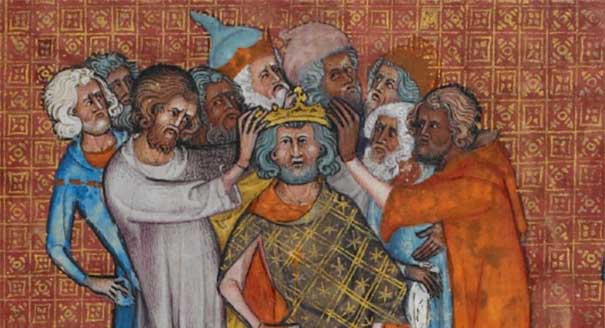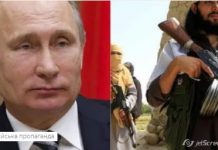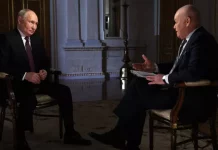
The Moscow-based polling organization Levada Center recently published a survey showing Russian President Vladimir Putin’s approval ratings at a record high of 89%. Levada was immediately flooded with accusations of bias, corruption, and lack of professionalism—as well as with assertions that public opinion cannot be measured in an authoritarian state. Some observers say that the president’s rating is an inexplicable anomaly: that it’s simply impossible in a country where the government is oppressing its citizens and economic crisis is deepening.
These critics are forgetting a few things. Just a year and a half ago, the legitimacy of the entire political system was in jeopardy, and it seemed like nothing could stop political ratings from plummeting—not the 2014 Sochi Winter Olympic Games, not the electoral campaign. If you look at the entire 15 years that Putin has been in power, rather than just the last year and a half, you can see that this is the fourth time his popularity has soared this high. Furthermore, there are simultaneous changes in various indicators, which makes for a more complicated picture than what most observers see.
Four Peaks
Vladimir Putin’s popularity first surged in late 1999, when he was still prime minister. In the wake of apartment building bombings in three Russian cities, the ensuing Second Chechen War, and the start of economic revival, Putin’s ratings shot up from 31% in August to 80% in November. In March 2000, Putin’s ratings helped him secure the presidential election in the first round of voting. His poll numbers peaked a second time in December 2003 (86%), at the height of an election campaign that was accompanied by a crusade against local oligarchs and disagreements with the United States over the war in Iraq.
His approval ratings reached 86-87% for a third time during the 2007-2008 electoral campaign, which saw the “managed transfer” of the presidency from Putin to Dmitri Medvedev. This was the apex of “Putin’s stability,” and there was no crisis in sight. Putin’s approval ratings reached a record high of 88% in September 2008, right after the brief war with Georgia.
But for the four years after that, right up until February 2014, Putin’s popularity was gradually waning. During those years, Putin lost about a third of his supporters. But then his rating was back to a historic high for the fourth time in 2014, in the wake of the annexation of Crimea and the resulting standoff with the West. What’s different this time around is that his ratings have remained that high for more than a year—albeit in 2007-2008 they didn’t dip below 80% for almost two years.
People often forget that several different indicators can be used to better understand changes in the president’s public approval. Last year, all of these indicators were positive: for example, only 34% of respondents expressed trust for Putin in January 2014, but 51% did so in March and 59% do today. In early 2014, there was a difference of 15 percentage points between Putin’s approval rating and that of the next most popular politician in the country, Defense Minister Sergei Shoigu. Now this gap has grown to 35 percentage points.
Readiness among Russians to vote for Putin in the next presidential elections has also risen, from 30% in early 2014 to 46% in late March 2014, and finally to 57% in August 2014. Since then, the indicator has hovered at around 55%. Among poll respondents who asserted that they did plan to vote, 80% said they would reelect Putin.
The sentiments people feel toward Putin have also changed. Two years ago, apathy prevailed, with indifference toward the president accounting for 50% of responses (another 20% said they had positive feelings toward him, 25% said they had negative feelings). Russians were beginning to tire of their president.Today, however, positive sentiments are 2.5 times more common (10% said they admired him, and 37% said they had a favorable opinion), while neutral or negative feelings were less common (40% and 11%, respectively). Finally, the distribution of responses to the question “why do many people trust Putin?” has changed. Two years ago, the dominant answer was “because people don’t know who else to trust” (42%). Today, this response is about half as popular (23%), while the most common opinion was that “Putin is successfully and commendably resolving Russia’s challenges” (up to 38% from 14% over the course of two years).
At the same time, approval of the president, support of the government as a whole, and the popularity of particular government policies are all different indicators with different values, and shouldn’t be conflated. For example, 89% approve of Vladimir Putin but only 66% approve of Dmitri Medvedev’s actions as Prime Minister, and a mere 19% say they trust him. Yet most people still do not want the government to be disbanded: 62% support the overall performance of the government. As another example, 70% of respondents believe that the majority of the population supports Putin, but the share of those who have the same opinion of public support for the government overall is a bit less than 40%.
Russians have mixed feelings about some of Putin’s policies, including on Ukraine. The annexation of Crimea has remained popular over the past year: 88% approved of it in March 2014, and approximately the same number still does. However, opinions on what would be an acceptable outcome of the situation in east Ukraine has changed drastically. In March 2014, 74% were ready to support the Russian leadership in the event of an open military conflict with Ukraine, but by February 2015 that number dropped to 44%. Sentiments about the eastern Ukrainian territories has changed in a similar fashion: at first 48% felt that these territories should be integrated into the Russian Federation, but now that number has dropped by more than three times (15%).
There are a few other important things to take note of. Putin’s approval ratings have changed considerably over the 15 years he has been in power. Between 2009 and 2014 he lost about a third of his supporters, but 2014 was a turning point due to extraordinary circumstances. All indicators show that attitudes toward Putin improved. Today, his image is back to that of Putin before the 2008 economic crisis.
Multiple major changes in approval ratings in a matter of weeks undermine the criticism of those who ascribe polling fluctuations to shortcomings in survey methodology. Factors such as respondent inaccessibility, the proportion of individuals who leave their contacts after the interview (to allow for reviewing of the survey process), and the participants’ fears that “wrong” answers could have negative consequences for them—all of these factors have remained constant over the past 10-15 years. The question of survey methodology is an important one, but is also enduring, and it can explain neither fluctuations in the surveys nor the high approval ratings shown in the past year. The real reasons lie elsewhere.
Sources of legitimacy
Many experts attribute Putin’s high ratings and political stability in Russia to the regime’s skill in manipulating public opinion through propaganda, which has been particularly intense since the start of the Ukraine crisis. The results of public opinion surveys support the notion that the events in Ukraine have virtually monopolized the attention of Russian audiences in 2014. Throughout the year, these developments (the annexation of Crimea, clashes in eastern Ukraine, humanitarian convoys, etc.) have been occupying 6-8 positions in the top 10 list of “most important and prominent events,” monitored by the Levada Center. Notably, Russia’s actions in Ukraine are seen in a very different light within Russia compared to elsewhere. For example, only 30% of Russians believe that Russia and Ukraine are at war, while 70% of Ukrainians do. The perception of most Russians is that their country’s role is limited to providing humanitarian support for Ukraine’s distressed civilian population, shipping humanitarian goods, and sending volunteers.
However, it would be a mistake to say that the propaganda is effective only because Russians have no access to alternative sources of information. At least 30% of Russians regularly get information from at least one independent source; in Moscow and other large cities, this figure is as high as 60% (meanwhile, Putin’s Ukraine policy is only marginally less popular in urban areas than it is nationwide). A considerable share of Russians are aware of the existence of other viewpoints, but they don’t want to listen or take them into account.
This happens because, for the first time since the collapse of the Soviet Union, the annexation of Crimea made Russians feel like they were a superpower again (80% of respondents agreed with this statement in spring 2014). Most Russians are unable or unwilling to shake off the intoxicating illusion of national grandeur. Propaganda also keeps the nation from coming to its senses because it helps shift focus from one topic to another—from the annexation of Crimea to the wrongdoings of the Ukrainian army to the evil of the West and its sanctions, and so on. The spin-doctors are always on the lookout for new stories to keep the public’s attention from waning.
Another factor that helps guarantee support for the regime is that there are no real alternatives. As mentioned above, between one quarter and a third of Russians support Putin because there isn’t anybody else to compare him with. Independent candidates have no access to TV airtime, and their ability to participate in elections at all levels is seriously limited. The appearance of an alternative candidate can rapidly and radically change the situation. The 2013 Moscow mayoral elections is a good example of that: opposition candidate Alexei Navalny was able to improve his standing in the polls by several times in a matter of months, and he eventually took 27% of the vote. Almost half of Putin’s supporters are people without clear political opinions, who have little interest in politics. These people are particularly susceptible to the pressure of propaganda, their bosses at work, and local authorities. They are the ones who have neutral feelings toward Putin (“Can’t say anything bad” and “Can’t say anything good” about him). Overall, they don’t really care who they vote for.
Yet the authorities are not the only ones to blame for the lack of political alternatives. The opposition bears part of the responsibility, because non-systemic opposition parties almost completely ignore issues that concern the majority of the population. It’s the Kremlin that plays the lead when it comes to discussing the issues that worry most average Russians. For all of its corruption and red tape, the Russian government remains, in the opinion of most of its citizens, the only place to turn for assistance. The opposition, on the other hand, is frequently disrespectful of the general public. It should therefore come as now surprise that most Russians feel that the opposition “only cares about getting into power, and has no concern for the little people.” Only 11% disagree with this statement.
Finally, the key instrument for securing Putin’s base of support is the policy of sustaining social stability. This is particularly important given that almost half the Russian population believes that they would have a difficult time surviving without government assistance. Putin is associated with the boom years of the 2000s. One of the biggest challenges to Putin’s popularity as of yet was brought on by social instability. In 2005, monetization of benefits brought about a considerable drop in the president’s approval ratings (to 60%), as well as nationwide protests. The monetization reform had to be called of halfway through. This development appears to have served as an important lesson for Putin and his team, giving them an appreciation for the value of social stability in upholding the political order.
The managed transfer of power to Dmitri Medvedev in 2007-2008 was carried out under precisely this motto of preserving “Putin’s stability.” Today, preserving social guarantees is the government’s top priority. It is likely that Putin’s ratings have stayed so high only because of the decisive actions undertaken by the government in late 2014 in order to quell the growing panic and stabilize the ruble exchange rate. Thanks to these measures, general mood that had crashed in December rebounded by early spring.
Anti-status Quo
In closing, we should reexamine the criticism of public opinion survey results by liberal segments of society. Such critiques have been common over the years, at some times becoming more intense. In the 2011 elections, for example, some observers were dissatisfied with survey results, where nationwide figures cited by sociologists differed vastly from their own experience with a limited sample of voters (our findings also suggest that data manipulations were possible, but on a much smaller scale than suggested by some critics). Public opinion centers have been accused of trying to demoralize protest-minded citizens with these survey results. When sociologists address pro-opposition audiences, they are always asked to “say something encouraging.”
It just so happened that, in the winter of 2011-2012, the interests of those who opposed the status quo aligned with the sentiments of the 35-40% of Russians who were at that point disappointed with the government. Many of the people who came out to Bolotnaya Square were first-time protesters, did not support the opposition’s leadership, and did not like many of the slogans they heard at the demonstrations. The government quickly gauged the situation and attempted to drive a wedge between the opposition activists and members of the general public who sympathized with them, but were ultimately fairly passive.Within a few months, the opposition was discredited in the eyes of the population and the protest movement was broken. Nonetheless, the Kremlin was only able to regain the approval of the disenchanted public following Russia’s annexation of Crimea. Those who want change in Russia must understand that, unless they can appeal to broad swaths of the population, they will always remain on the margins of political life. The opposition needs to try understanding the opinions of the majority, rather than disparaging them.
What can the history of public opinion polls tell us about the future of Putin’s approval rating? The annexation of Crimea and a standoff with the West has given Putin’s ratings (though not the ratings of other politicians, and not approval for the government overall), a “Teflon coating.” Putin’s popularity will remain high for awhile. Skilled propaganda, which is facilitated by control over leading media outlets and plays upon the existing fears and insecurities of the public, will slow a fall in Putin’s ratings. However, a further deterioration of the economy could undermine the key basis of the regime’s popularity: social stability. It should also be noted that the widespread public approval that is heavily dependent on compelling an apolitical majority to make “correct” political choices can rapidly dissolve. For example, the high ratings that former Moscow mayor Yuri Luzhkov enjoyed for a long time (at least in Moscow) were gone just a few weeks after he lost his position.
By Denis Volkov, Carnegie Moscow Center
Denis Volkov – sociologist, expert of the Levada Center





